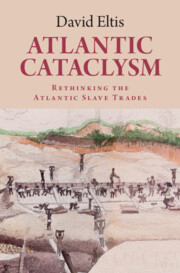Book contents
- Atlantic Cataclysm
- Atlantic Cataclysm
- Copyright page
- Epigraph
- Dedication
- Contents
- Figures
- Tables
- Maps
- Preface
- Acknowledgements
- Abbreviations
- 1 Atlantic Slave Trading and World History
- 2 The Americas and Atlantic Slave Trading: The Iberians and the Rest
- 3 Europe and Atlantic Slave Trading
- 4 The Portuguese System
- 5 Africa, Africans, and the Slave Trade
- 6 Abolition: A Leninist Interpretation
- 7 Freedom?
- Conclusion
- Index
1 - Atlantic Slave Trading and World History
Published online by Cambridge University Press: 13 December 2024
- Atlantic Cataclysm
- Atlantic Cataclysm
- Copyright page
- Epigraph
- Dedication
- Contents
- Figures
- Tables
- Maps
- Preface
- Acknowledgements
- Abbreviations
- 1 Atlantic Slave Trading and World History
- 2 The Americas and Atlantic Slave Trading: The Iberians and the Rest
- 3 Europe and Atlantic Slave Trading
- 4 The Portuguese System
- 5 Africa, Africans, and the Slave Trade
- 6 Abolition: A Leninist Interpretation
- 7 Freedom?
- Conclusion
- Index
Summary
Review of the inhumane practices of people in both New and Old Worlds prior to Columbian contact. Slave trading and cruelty were widespread, and slave trading was extensive. Most slaves were female, employed in domestic or agricultural environments (with little evidence of gang-labor), and came from a wide range of geographic areas and cultures. Most were born into slavery or were enslaved as a result of raids and wars in which many men on the losing side were killed. Slave markets existed across Eurasia, though in the pre-contact New World such markets were less common. After 1500, transatlantic trafficking came to draw exclusively on Africa or at least on Black people, probably because of the long isolation of the Americas from the rest of the world, and the inability of its Indigenous population to resist harmful pathogens from the Old World. Before 1820 migration to the New World was dominated by Africans rather than Europeans and by males (in contrast to the female-dominated slave populations of the Old World). White slaves were scarcely ever present in the New World.
- Type
- Chapter
- Information
- Atlantic CataclysmRethinking the Atlantic Slave Trades, pp. 1 - 45Publisher: Cambridge University PressPrint publication year: 2025

